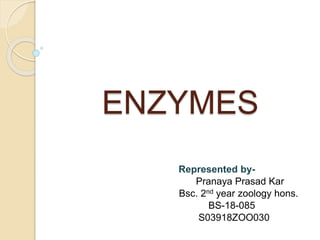
Enzymes copy
- 1. ENZYMES Represented by- Pranaya Prasad Kar Bsc. 2nd year zoology hons. BS-18-085 S03918ZOO030
- 2. What is Enzyme ? Enzymes are protein specialized to catalyze biological reactions. They are among the most remarkable biomolecules known because of their extraordinary specificity & catalytic power, which are far greater than those man-made catalyst.
- 3. Structure of Enzyme Enzymes are proteins (tertiary structure). They have a globular shape A complex 3-D structure
- 4. The Active Site Enzyme molecules contain a special pocket or cleft called the active sites. The area on the enzyme where the substrate or substrates attach to is called the active site.
- 5. Cofactors An additional non-protein molecule needed by some enzymes to help the reaction, is called as cofactors.
- 6. Substrate In enzymatic reactions, the substance at the beginning of the process, on which an enzyme begins it’s action is called substrate.
- 7. ENZYMES COMPLEX ENZYME APOPROTEIN (PROTEIN PART) PROSTHETIC GROUP (NON-PROTEIN PART) CO-FACTOR (INORGANIC ION) CO-ENZYME (ORGANIC ION) SIMPLE ENZYME
- 8. Nomenclature of Enzymes An enzyme is named according to the name of the substrate it catalyses. Some enzymes were named before a systematic way of naming enzyme was formed. Example: pepsin, trypsin and rennin By adding suffix -ase at the end of the name of the substrate, enzymes are named.
- 9. SUBSTRATE ENZYMES PRODUCTS lactose lactase glucose + galactose maltose maltase Glucose cellulose cellulase Glucose lipid lipase Glycerol + fatty acid starch amylase Maltose protein protease Peptides + polypeptide
- 10. Classification of Enzymes A systematic classification of enzymes has been developed by International Enzyme Commission. This classification is based on the type of reactions catalyzed by enzymes. There are six major classes. Each class is further divided into sub classes, sub sub-classes and so on, to describe the huge number of different enzyme catalyzed reactions.
- 11. ENZYME CLASS REACTION TYPE EXAMPLES Oxidoreductases Reduction-oxidation (redox) Lactate dehydrogenase Transferases Move chemical group Hexokinase Hydrolases Hydrolysis; bond cleavage with transfer of functional group of water Lysozyme Lysases Non-hydrolytic bond cleavage Fumarase Isomerases Intramolecular group transfer (isomerization) Triose phosphate isomerase Ligases Synthesis of new covalent bond between substrates, using ATP hydrolysis RNA polymerase
- 12. Intracellular and Extracellular Enzymes Intracellular enzymes are synthesized and retained in the cell for the use of cell itself. They are found in the cytoplasm, nucleus, mitochondria and chloroplast. Example : Oxydoreductase catalyses biological oxidation. Enzymes involved in reduction in the mitochondria. Extracellular enzymes are synthesized in the cell but secreted from the cell to work externally. Example : Digestive enzyme produced by the pancreas, are not used by the cells in the pancreas but are transported to the duodenum.
- 13. Activation Energy Activation energy is the minimum amount of energy that is required to raise the energy of molecules to a level at which the biochemical reaction takes place.
- 14. Enzymes Work by Lowering the Energy of Activation Enzymes increase the reaction rate by lowering the energy of activation.
- 15. Mechanism of Action of Enzymes • Enzymes increase reaction rates by decreasing the Activation energy. • Enzyme-Substrate Interactions: ‒Formation of Enzyme substrate complex by: ‒Lock-and-Key Model ‒Induced Fit Model
- 16. Lock and Key Model Proposed by EMIL FISCHER in 1894. Lock and key hypothesis assumes the active site of an enzymes are rigid in its shape. There is no change in the active site before and after a chemical reaction.
- 17. Induced Fit Model More recent studies have revealed that the process is much more likely to involve an induced fit model(proposed by DANIAL KOSH LAND in 1958). According to this exposure of an enzyme to substrate cause a change in enzyme, which causes the active site to change it’s shape to allow enzyme and substrate to bind.
- 18. Factors Affecting Rate of Enzyme Catalyzed Reactions Temperature Hydrogen ion concentration(pH)
- 19. Effect of Temperature Raising the temperature increases the rate of enzyme catalyzed reaction by increasing kinetic energy of reacting molecules. Enzymes work maximum over a particular temperature known as optimum temperature. Enzymes for humans generally exhibit stability temperature up to 35-45 ᵒC. However some times heat energy can also increase kinetic energy to a point that exceed the energy barrier which
- 20. Temperature
- 21. Effect of pH Rate of almost all enzymes catalyzed reactions depends on pH Most enzymes exhibit optimal activity at pH value between 5 and 9 High or low pH value than optimum value will cause ionization of enzyme which result in denaturation of enzyme.
- 22. pH
- 23. Inhibition The prevention of an enzyme process as a result of interaction of inhibitors with the enzyme. INHIBITORS: Any substance that can diminish the velocity of an enzyme catalyzed reaction is called an inhibitor.
- 24. Types of Inhibition Inhibition Reversible Competitive Uncompetitive Non- competitive Feedback Irreversible
- 25. Competitive Inhibition In this type of inhibition, the inhibitors compete with the substrate for the active site. Formation of E.S complex is reduced while a new E.I complex is formed.
- 26. Uncompetitive Inhibition In this type of inhibition, inhibitor does not compete with the substrate for the active site of enzyme instead it binds to another site known as allosteric site.
- 27. Non Competitive Inhibition It is a special case of inhibition. In this inhibitor has the same affinity for either enzyme E or the E.S complex.
- 28. Feedback Inhibition Feedback inhibition is the phenomenon where the output of a process is used as an input to control the behavior of the process itself, oftentimes limiting the production of more product. Although negative feedback is used in the context of inhibition.